February 23rd, 2024
Part Three: Central Park as An Outdoor Museum
The four perimeter corners of the park, which are defined by their existence as exterior public spaces to Central Park, are obvious sites for the erection of memorial sculptures. Three of these are the result of a reconsideration of traffic circulation combined with a desire to create meaningfully located and purposefully designed platforms for the erection of commemorative sculptures.
The alterations to the existing designs of these public space adjuncts to Central Park – Frederick Douglas Circle at 110th Street and Central Park West; Duke Ellington Circle at 110th Street and Fifth Avenue; The Maine Monument plaza at Columbus Circle; and Grand Army Plaza at 59th Street and Fifth Avenue, which dominate the views from their surrounding streets – became an encompassing part of the vision of the Conservancy’s 1985 Management and Restoration Plan. Its restoration design and construction team was therefore tasked with drawing up plans for the landscape renovation and monument restoration of these public spaces. Blueprints and scale drawings were then submitted to the New York City Landmarks Commission, New York Art Commission, and the community planning boards whose purview included the proposed restoration project at each of the four public-space adjuncts to Central Park.
_
Columbus Circle, a conspicuous urban landmark at the nexus of the traffic circle defined by the intersection of Broadway, Central Park West, Eighth Avenue, 59th Street, and the southwest entrance to Central Park boasts a monument to the legendary discoverer of America, Christopher Columbus. A full-length marble portrait of Columbus by Jeronimo Sunol stands atop a colossal column pierced by the explorer’s three legendary boats – the Niña, the Pinta, and the Santa Maria.
USS Maine National Monument
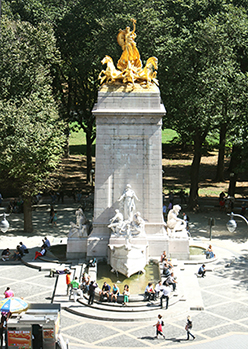
USS Maine National Monument
To enter Central Park, one takes the pedestrian crossing at Columbus Circle to the terrace surrounding the USS Maine National Monument.
In front of Merchants’ Gate, the most heavily used entrance to the Park with nearly 4 million visitors annually (or 10 percent of total Park visitors) is a massive multiple-figured monument commemorating the 260 American sailors who perished in 1898 when the USS Maine exploded while in harbor in Havana, Cuba. Installed in 1913, it is the work of Attilio Piccirilli, an Italian stonecutter and sculptor who, with his father and five brothers, carved many of the better marble statues produced in this country at the turn of the twentieth century. With its arrangement of multiple figures as a comprehensive composition, it is the largest and most complex sculptural memorial in Central Park.
Characteristic of the Beaux-Arts movement, the memorial is composed of a series of allegorical figures that, although not readily identifiable today, have narrative attributes that can be deciphered. Its crowning glory is the triumphant figure of Columbia flanked by figures representing the Atlantic and the Pacific Oceans. Projecting out of a heroic pylon is the bow of a ship symbolizing “Anti-Bellum State of mind” in which Peace stands with outstretched arms while Courage and Fortitude sit at her feet and a youthful figure of Victory at the prow holds an olive leaf in each hand. On the reverse of the pylon “Post-Bellum Idea” is represented by the figure of Justice receiving back the sword which she entrusted to the Genius of War while History at her feet records these deeds.
Duke Ellington Memorial
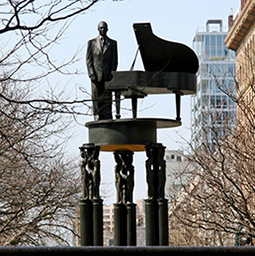
Duke Ellington Memorial
At the diagonally opposite end of the park from Columbus Circle and the Maine Monument is the Duke Ellington Memorial whose stage is the reconfigured former Frawley Circle, a traffic nexus with a circumference that embraces the intersection of 110th Street and Fifth Avenue. The first public monument in New York City dedicated to an African American, the sculpture was created in 1997 by Mexican-born sculptor Robert Graham. Looking up one sees a ten-foot-high figure of the famous American composer, pianist, and originator of big-band jazz Duke Ellington (1899–1974) standing next to a grand piano on a circular platform supported by three columns, each of which is topped with a pair of nude female figures. Instead of gold-gilded bronze like the one of Columbia Triumphant at the Maine monument and the equestrian sculpture of General Sherman at Grand Army Plaza, Ellington’s memorial has a polished black surface keying off the ebony patina of concert-hall grand pianos, which gives it verisimilitude and visual prominence within its surrounding streetscape and through the treetops at Central Park’s northeastern corner.
Frederick Douglass Memorial
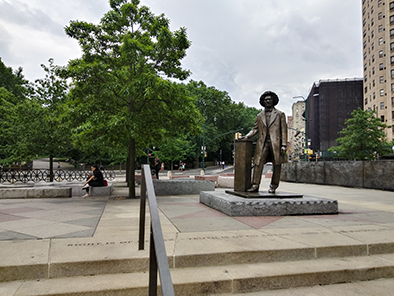
Frederick Douglass Memorial
If you walk from the Duke Ellington monument west along 110th Street past Malcolm X and Adam Clayton Powell, Jr. Boulevards you are traversing the gateway to Harlem, which is anchored by Frederick Douglas Circle, a 2003 urban planning feat at the northwest corner of Central Park, which was configured in a similar fashion as Columbus Circle, was a traffic intersection with arching turn lanes at its corners creating an irregular “circle” was named in the 1950’s for Frederick Douglass, famed orator and guiding spirit of the Emancipation movement.
The resulting transportation engineering created an island of public space, for which there was a design competition to create a commemorative monument honoring the great African American abolitionist and political leader. The winning team included local Harlem artist Algernon Miller and Hungarian-American sculptor Gabriel Koren. Miller undertook the overall design for the plaza, including a fountain, and Koren designed the statue of Douglass. Her statue stands at ground level rather than on pedestal, making the figure of Douglass approachable and humble. The artists shared and inspired efforts result in a public space that engages the visitor, conveying Douglass’ life struggles through historic text embedded throughout the plaza’s various design elements, the centerpiece of which is Koren’s eight-foot-tall bronze portrait monument of Frederick Douglas.
According to John Reddick, the Conservancy’s Director of Community Engagement Projects, the monument holds for him both personal and public meaning. Typically, he approaches the monument from Harlem to the north, a community where he’s lived for decades. From there one enters the plaza and climbs a brief series of steps, where upon they engage Frederick Douglass face on at the top. To Reddick, the artist’s skilled hand “conjure Douglass with a charm and stature that resonates with all we’ve come to embrace and admire in the daguerreotype images of him. The era’s finely tailored garments and unruly hair hew to a true-to-life appearance of the man while at the same time appearing present-day stylistically. Despite having made similar countless visits, I always still take in his hands, one resting at his side and the other on a podium, and I pause to marvel that they were modeled on my own.” (To his surprise, during a visit by Reddick to Koren’s studio she made an impromptu casting of his hands as a model from which to work).
William Tecumseh Sherman, Grand Army Plaza
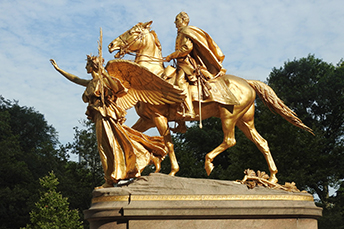
William Tecumseh Sherman
The Civil War, or “War Between the States,” as Southerners loyal to what would become called the “Lost Cause,” ended in a Union victory on December 21, 1964, sealing the preservation of the original republic wrought by the founding fathers and its further incorporation of new states carved out of the westward -moving frontier. This final triumph through military strategy involving 60,000 Northern soldiers under the command of General William Tecumseh Sherman (1829–1891) occurred with a 285-mile scorched earth march to the Atlantic coast of the continental nation, with the North claiming victory after the burning of Atlanta and subsequent conquest of Savannah, while liberating thousands of enslaved African Americans in their path.
The fact that Sherman’s “hard hand of war” demoralized Confederates, hastening the end of slavery and the reunification of the nation made him a hero to be honored by a monumental statue of considerable prominence. It was fitting that his memorialization in such a manner should occur in New York City where the Union soldiers belonging to the elite, socially prominent Seventh Regiment had played an important role in the Civil War. In the meantime, in New York City the war had not put an end to the influence of the neoclassical style of Beaux-Arts urban planning with which Baron Eugene Haussmann (1809–1891) had reconfigured the layout of Paris. The paradigm of grand boulevards interwoven with public squares designed as receptacles for patriotic historical memorials such as the 1772 Place de Concorde, which was famous as the execution site where Louis XVI and Marie-Antoinette were guillotined, provided a public-space model that the grid-plan engineers laying out New York City’s street system were able to insert into the environs of the Fifth Avenue mansions of the Gilded Age. Thus, while General Sherman’s ravaging of the South had left a wake of bitter woe throughout the former Confederacy, Union military sentiment, as exemplified by the name Grand Army Plaza, made this peripheral appendage to Central Park an ideal location for a monumental equestrian statue of the general who had led the Union to victory. This Beau-Arts urban planning ideal was designed as two facing semicircular islands similar in shape to those that form the Place de la Concord.
As early as 1898 the Viennese-trained Austro-American sculptor Karl Bitter (1867–1915), had proposed that this two-part public space inserted into New York City’s grid plan should serve as an integrated single one. Plans were drawn by the sculptor shortly thereafter envisioning the plaza as being divided into two large lobes with a broad sidewalk and balustrades flanking them and a central promenade connecting complementary fountains at each end. However, Bitter’s worst fear, a piecemeal treatment of the Plaza, began to materialize when the premier nineteenth-century American sculptor Augustus Saint-Gaudens (1848–1907) was commissioned to create the General William Tecumseh Sherman monument. Unveiled on May 30, 1903, on the northern lobe of the Grand Army Plaza, Saint-Gaudens’s monument was revealed to be a worthy successor of two of the most famous equestrian statues in the history of Renaissance art: Donatello’s Gattamelata in Padua and Verroccio’s Bartolomeo Colleoni in Campo Sanati Giovanni e Paolo in Venice.
In 1912 Bitter’s hope for a unified treatment of the Plaza received a second blow when Joseph Pulitzer bequeathed fifty thousand dollars “for the creation of a fountain at some suitable place in Central Park, preferably at or near the Plaza entrance at Fifty-ninth Street.” Nevertheless, Bitter continued to play a role in the future of the Grand Army Plaza when the executors of Pulitzer’s estate selected him as one of the sculptors to submit designs for the proposed fountain. Furthermore, he was a member of the Art Commission of the City of New York, which had jurisdiction over all such projects.
From the outset Bitter opposed the fountain on the grounds that fifty thousand dollars was not enough to carry out his plan for the Plaza. A compromise was finally reached when the city agreed to finance the architectural treatment of the whole Plaza, while the Pulitzer bequest would be used to defer the cost of a fountain to counterbalance Saint-Gaudens’s 24-foot-high monument Sherman.
According to the Central Park Conservancy’s website the completion date of the monument, which was intended for 1894, was not realized until 1903, due in part to debate over its location. Some of the sites under consideration were the southern end of the Mall in Central Park and Riverside Park near Grant’s Tomb, but the north lobe of the Grand Army Plaza close to the 59th Street entrance at the southeast corner of the Park was ultimately chosen because its openness to the surrounding sidewalks and the Fifth Avenue / 59th Street entrance to Central Park best accommodated views of the dramatic statue of Sherman, which continues to hold its rank as one of the world’s greatest masterpieces of equestrian sculpture. And, to that end one must admire Saint-Gaudens’s assessment of his own artistic strengths and weaknesses, engaging as he would the talents of renowned animal sculptor Alexander Phimister Proctor to execute the horse, and architect Charles McKim to design the monument’s granite base.
The monument, which was unveiled in 1903, depicts Sherman on his horse, Ontario, led by the allegorical figure of Victory. The model for “Victory” was an African-American woman named Hettie Anderson who worked as a model for many of the era’s most prominent painters and sculptors. The figure of Victory is depicted holding a palm frond as she leads Sherman to Union victory. Sherman’s horse is trampling a Georgia Pine branch, a symbol of the south.
In September 2015 the Central Park Conservancy completed a major restoration of the northern half of Grand Army Plaza, including a conservation and re-gilding of the Sherman monument. The project involved cleaning the bronze and applying new gold leaf to the surface of the statue. A protective coating of wax – tinted to emphasize the sculptural detail of the monument – was layered on top. The Conservancy also restored the Plaza to its original 1916 design, including installing a double row of street trees, benches, lamps, and paving stones.
Strawberry Fields
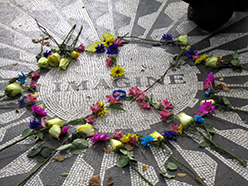
John Lennon Imagine Memorial
The current most purposefully visited single monument in Central Park is not a gilded bronze statue or sculptural portrait of any kind. Bump into a tourist on a pathway in the park and you may be asked, “How do I get to Strawberry Fields?” They come by the thousands each year to pay homage to the famous rock band guitarist and Beatles songwriter John Lennon, some with bouquets of flowers to lay within a mosaic circle centered by the single word IMAGINE close by the 72nd Street and Central Park West entrance to the park opposite the apartment where Lennon, his wife Yoko Ono, and their son Sean Tara Ono Lennon lived.
Remembering the vigil in front of the candle-lit band shell on the Mall following Lennon’s death on December 8, 1980 and then accepting on behalf of the Central Park Conservancy Yoko’s $1 million gift to be allocated at the Central Park Conservancy’s behest directing that one-half of the amount go for the expenditure necessary for the renewal of the deteriorated landscape in an Olmstedian manner according to the Conservancy’s management and restoration plan and the other into an endowment that would hire the Conservancy’s first zone gardener, initiating a practice that has now become modus operandi throughout the entire park where there is now a continuity of defined sections to which zone gardeners are assigned to provide daily maintenance to defined areas covering the entire breadth of the park.
Now, looking out my window at Central Park more than forty years later and considering that it remains a beacon of peaceful life and wholesome happiness in a world in turmoil on a dying planet, I find myself mentally humming the song that gives John Lennon’s memorial its special meaning:
Imagine there’s no heaven
It’s easy if you try
No hell below us
Above us, only sky
Imagine all the people
Livin’ for today
Ah
Imagine there’s no countries
It isn’t hard to do
Nothing to kill or die for
And no religion, too
Imagine all the people
Livin’ life in peace
You
You may say I’m a dreamer
But I’m not the only one
I hope someday you’ll join us
And the world will be as one
Imagine no possessions
I wonder if you can
No need for greed or hunger
A brotherhood of man
Imagine all the people
Sharing all the world
You
You may say I’m a dreamer
But I’m not the only one
I hope someday you’ll join us
And the world will live as one
_
Imagine there’s no heaven
It’s easy if you try
No hell below us
Above us, only sky
Imagine all the people
Livin’ for today
Ah
Imagine there’s no countries
It isn’t hard to do
Nothing to kill or die for
And no religion, too
Imagine all the people
Livin’ life in peace
You
You may say I’m a dreamer
But I’m not the only one
I hope someday you’ll join us
And the world will be as one
Imagine no possessions
I wonder if you can
No need for greed or hunger
A brotherhood of man
Imagine all the people
Sharing all the world
You
You may say I’m a dreamer
But I’m not the only one
I hope someday you’ll join us
And the world will live as one
Share
